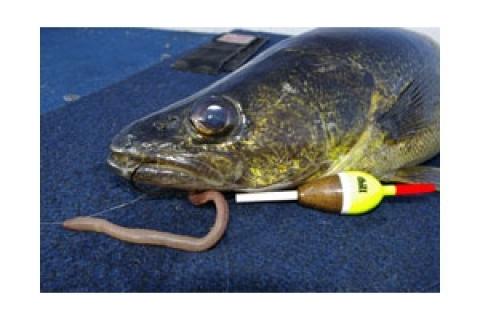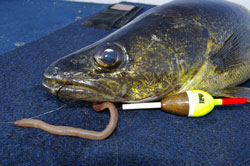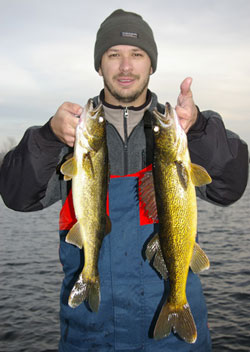
Across North America, the walleye rates as one of the most sought after and favored game fish among anglers. Techniques for catching these critters may be well-known and elementary, and those include jigging, trolling and bottom bouncing. (Methods elementary in name, I admit, but advanced and intricate in technique and application.)
But how many anglers routinely pack floats, split shot and live bait, searching out precise structure to drift their offerings across? Certainly the minority, but hopefully more will come on board after recognizing the success this technique can bring.
Basics of Bobbering
We all received our start in fishing courtesy of a bobber. The days were simple back then, but the set-up always caught fish. Times have changed, and the use of slip-bobbers (or floats) has put a new twist in the live bait game, and the fish-catching powers certainly have continued.
Utilizing a float and live bait allows an angler to present their morsel of food to walleye at the precise depth that fish may be found. For the most part, the desired depth would be just off bottom — a favorite hangout for these structure-hugging fish.
 |
| Slip-bobbering is an excellent, yet underutilized technique that can reap great rewards. |
Slip floats are designed to move freely up and down your line, as the chamber of the float is hollow. By threading your line through the float itself, it is simply a matter of attaching a live bait hook, as well as split shot above the hook to weight your presentation. Place a bobber stop above your float at the desired depth you wish to target. These bobber stops (whether they be small rubber pellets or vinyl tie knots) will pass easily through your line guides and onto the spool of your reel. Therefore, casting "normally" — without twenty-feet of line hanging from your rod tip — can easily be achieved.
A bobber stop should slide easily up and down your line, but should stay set at the desired depth you wish to fish. Many bobber stops come rated for certain pound-test line, so pay careful attention to this when making your purchase.
An Octopus hook is the most commonly used with this set up, although Circle hooks are also very effective. Hooks will generally range from No. 4 to No. 8, with the 4s being most effective for large minnows and the smaller sizes for leeches and nightcrawlers. Another alternative to a regular hook is a standard jig head. Depending on depth or bobber floatation, a 1/64 to 1/8-ounce style would work well, offering the fish a horizontal presentation as opposed to a vertical one, as well as the option to provide color.
As far as baits are concerned, minnows, leeches and crawlers are the cream of the crop (check local regulations to see what is legal). Minnows work great in the spring and fall, with leeches and worms throughout summer. Working all three baits on a given day can be an excellent study for what produces best on different bodies of water.
Finding a Float
 |
| A prime example of a slip-bobbering spot- a large flat adjacent to a pronounced point. |
Standard floats will cover most situations you come across, but variations in style and design do have their advantages:
- Fat-bodied round float or pear floats are a breeze to cast and will ride waves well; however, they do require more effort to pull under. They also blow around more easily with the wind.
- Pencil floats, those that have a thinner profile, offer the least resistance — so they cast further, drift along more slowly, and work best for light biters.
- Tall, oval floats will get pushed along a drift quickly, and they can be useful when trying to cover large expanses of water.
- Lighted floats are specifically meant for night fishing or low-light conditions.
I suggest outfitting your box with a variety of floats, as this will enable you to fish in various situations most effectively. Acknowledging wind speed, distance, current and bait will help in deciding on the right float. Larger bait, especially big lively minnows, will require an upgrade in float size. Leeches or worms, which don't offer as much of a pull, can be worked with downsized floats.
Weighting your line correctly is also paramount when slip-bobbering. When a fish sucks in your bait, you need that slight movement to register immediately on top. Adding the correct weight to your line will ensure that your float goes under with nary a hesitation.
Place split shot in 8- to 12-inch increments from the hook, starting with a smaller size and gradually getting larger. This placement will keep your line vertical through the water, while your bait will appear more natural toward the hook end.
Location is Key
Walleye are renowned for the structure they inhabit, and for the most part, it is the hard stuff. Rock generally holds walleye, with vegetation also being popular, depending largely on the chosen lakes makeup.
Slip floats are an excellent choice when working rock shoals, humps, points and flats. By using your electronics to ascertain a depth, your bobber stop should be placed to present your bait 6- to 12-inches off bottom. Although walleye may suspend at times, for the most part, they will be right on bottom, hugging the structure. If your float sits flat on the surface, your bait is laying on bottom. Adjust the bobber stop until the float sits perfect in the water.
 |
| The author displays the results of a day working a float - golden yellow walleye! |
It is crucial to get the correct depth when slip-bobbering. If the bait is too high in the water column, the fish will pass it over. Go too low and you'll be snagging on bottom.
Whether you want to cover a larger area or concentrate on a small dissection of structure will often depend on the area you choose to fish. Small humps are best worked in a stationary manner. Large flats, on the other hand, should be drifted more vigorously in order to search and find fish.
Rods and Line
Although most "regular" rods will work for slip-bobbering, this technique can be improved with a bit of tinkering. Seven to 8-foot spinning rods may seem long, but the added length can vastly improve casting distance, as well as hook sets and the playing of fish. I prefer to partner this up with a quality spinning reel, sporting a smooth drag. As far as line is concerned, six or eight-pound test mono is an excellent choice for the main section. A fluorocarbon leader is a good choice down below, as it will complement the natural presentation you are trying to convey.
Drifting your bait to eager walleye is an excellent technique that is greatly under utilized. The next time you hit your favorite shoal or hump, come toting floats and live bait — there's nothing like seeing your bobber going under to ignite some passion in the fishing game.
- 2722 views

